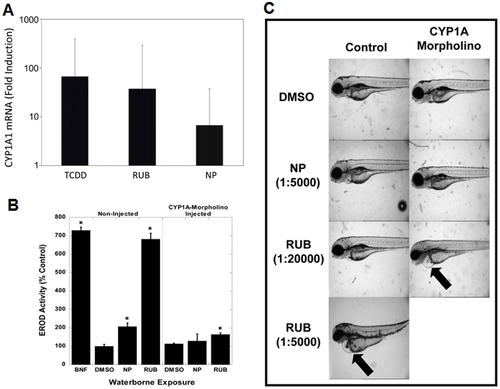Fig. 4
- ID
- ZDB-FIG-130410-8
- Publication
- Zhao et al., 2013 - Common commercial and consumer products contain activators of the aryl hydrocarbon (dioxin) receptor
- Other Figures
- All Figure Page
- Back to All Figure Page
|
Effect of extracts of newspaper and rubber on human skin CYP1A1 mRNA, embryonic zebrafish CYP1A-dependent EROD activity and zebrafish development. (A) Human skin was incubated with the indicated extract (newsprint (NP) or rubber stopper (RUB) at 1% final concentration) overnight at 37°C, mRNA was isolated and transcribed into cDNA and quantitated by real time PCR. Values are expressed as the mean ± SD of 4 (TCDD) or 6 (extract) individual skin samples. All values were significantly different from those of DMSO controls (set to 1) at p<0.05 as determined by one-way ANOVA using Stata/SE9.2 software for Windows with Bonferroni corrections. (B) Newly fertilized zebrafish embryos were exposed for 96 h to DMSO (0.02% v/v), newspaper (NP) extract (1:5,000 dilution), or rubber (RUB) stopper (1:5,000 or 1:20,000 dilution) added to the water and some also injected with 2 pumps of 1× Danio embryo water or embryo water containing 0.15 mM CYP1A-morpholino; additional embryos were exposed to the AhR agonist beta-naphthoflavone (BNF, 1 μg/L) as the positive control for the same period. Hatched larvae were collected and analyzed for EROD activity. EROD values are expressed as the mean ± SE of 5 embryos, where the asterisk indicates those values significantly different from the DMSO control at p<0.05 as determined by Student′s t-test. (C) The hatched larvae treated with extracts as in Figure 5B were examined for deformities by brightfield microscopy. |

